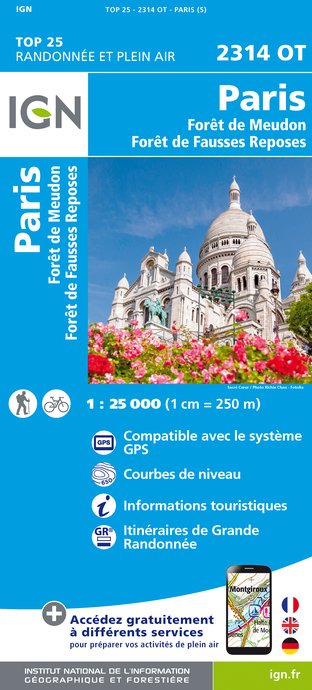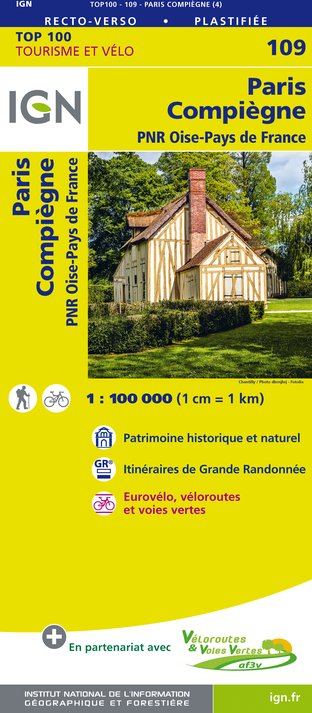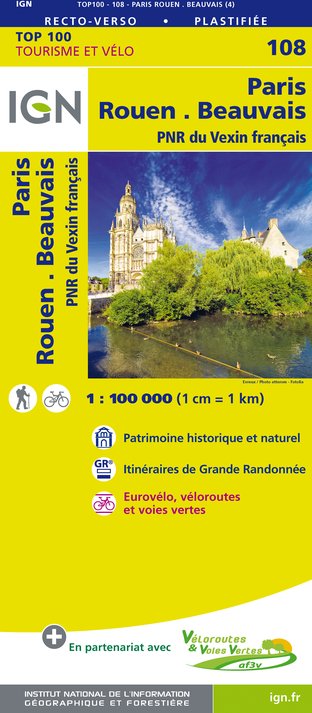警报
警报
练习类型
徒步
自行车
Presentation
地图
兴趣点
Cirkwi 简报
评级和评论
周围的看点
塞纳河的未知女子

信用 : unbekannt
Cirkwi 简报
揭示巴黎:塞纳河的未知女子之旅
由Balades Fluviales Fabienne Lemoine Fondateur提出的这条行程将您带入一个充满神秘和艺术色彩的巴黎故事中。塞纳河的未知女子,她死去的美丽激发了无数艺术家和作家的灵感,成为巴黎昔日的引导者。这段旅程带我们超越了常规的地标,探索城市灵魂的深处。当我们踏上巴黎历史的脚步时,我们会想起美丽可以从悲剧中诞生,在光之城市上投下一种永恒的诱惑。这条独特的路径承诺探索巴黎鲜为人知的故事,由塞纳河低声细语而来。
行程技术概述
这条步行路线总长约3.87公里,穿越的海拔高度从27米到最高37米。攀升和下降略有起伏,总体高差在5-7米之间。这样的地形轮廓表明适合各个健康水平的参与者进行休闲步行。由于相对较短的距离和最小的海拔变化,这个行程很容易完成,无需专业装备或广泛的身体准备,充足的时间可以用于思考和发现。
旅行者的季节提示
在计划您的参观时,请考虑巴黎的季节变化。春天和秋天气温温和,人流较少,非常适合在城市历史路径上进行漫步。夏天,巴黎的美丽是无可否认的,但要准备迎接更多的人群和更炎热的天气,保持水分和防护措施是必需的。冬天有自己的魅力,游客较少,可能会看到巴黎被雪覆盖的景象。请确保穿着多层衣物和舒适的鞋子,因为路面情况各异。无论季节如何,出发前始终检查天气预报,以享受巴黎的最佳体验。
巴黎:一个沉浸在历史中的城市
在巴黎的旅程不仅仅是一次步行,它是一段时间的旅程。这座城市深植于法国文化和历史的心脏,为过去提供了独特的视角。巴黎这座迎接革命、胜利和悲剧的城市,邀请探险家深入其丰富的文化群织。该地区的历史意义超越法国,对全球范围的艺术、政治和文化产生影响。这个行程将一个未知女子的故事提升为巴黎持久的神秘和美丽的象征,展示了这座城市无论经历多少岁月仍能吸引人们的想象力。
巴黎旅行者的气候见解
巴黎的气候以温和而略微不可预测为特点。冬天凉爽,有时会有霜和少量降雪,而夏天可以暖和但不过分,为探索提供了舒适的氛围。最佳参观时间通常在晚春(5月至6月)或早秋(9月至10月),此时天气宜人,城市的花园盛开或壮丽变幻。这两个季节为追溯塞纳河的神秘未知女子的足迹提供了绝佳的背景,少雨打扰和温和的气候增强了整体体验。
由Balades Fluviales Fabienne Lemoine Fondateur提出的这条行程将您带入一个充满神秘和艺术色彩的巴黎故事中。塞纳河的未知女子,她死去的美丽激发了无数艺术家和作家的灵感,成为巴黎昔日的引导者。这段旅程带我们超越了常规的地标,探索城市灵魂的深处。当我们踏上巴黎历史的脚步时,我们会想起美丽可以从悲剧中诞生,在光之城市上投下一种永恒的诱惑。这条独特的路径承诺探索巴黎鲜为人知的故事,由塞纳河低声细语而来。
行程技术概述
这条步行路线总长约3.87公里,穿越的海拔高度从27米到最高37米。攀升和下降略有起伏,总体高差在5-7米之间。这样的地形轮廓表明适合各个健康水平的参与者进行休闲步行。由于相对较短的距离和最小的海拔变化,这个行程很容易完成,无需专业装备或广泛的身体准备,充足的时间可以用于思考和发现。
旅行者的季节提示
在计划您的参观时,请考虑巴黎的季节变化。春天和秋天气温温和,人流较少,非常适合在城市历史路径上进行漫步。夏天,巴黎的美丽是无可否认的,但要准备迎接更多的人群和更炎热的天气,保持水分和防护措施是必需的。冬天有自己的魅力,游客较少,可能会看到巴黎被雪覆盖的景象。请确保穿着多层衣物和舒适的鞋子,因为路面情况各异。无论季节如何,出发前始终检查天气预报,以享受巴黎的最佳体验。
巴黎:一个沉浸在历史中的城市
在巴黎的旅程不仅仅是一次步行,它是一段时间的旅程。这座城市深植于法国文化和历史的心脏,为过去提供了独特的视角。巴黎这座迎接革命、胜利和悲剧的城市,邀请探险家深入其丰富的文化群织。该地区的历史意义超越法国,对全球范围的艺术、政治和文化产生影响。这个行程将一个未知女子的故事提升为巴黎持久的神秘和美丽的象征,展示了这座城市无论经历多少岁月仍能吸引人们的想象力。
巴黎旅行者的气候见解
巴黎的气候以温和而略微不可预测为特点。冬天凉爽,有时会有霜和少量降雪,而夏天可以暖和但不过分,为探索提供了舒适的氛围。最佳参观时间通常在晚春(5月至6月)或早秋(9月至10月),此时天气宜人,城市的花园盛开或壮丽变幻。这两个季节为追溯塞纳河的神秘未知女子的足迹提供了绝佳的背景,少雨打扰和温和的气候增强了整体体验。
自动生成。
IGN 地图

2314OT - PARIS FORÊT DE MEUDON FORÊT DE FAUSSES REPOSES
编辑器 : IGN
收藏 : TOP 25 ET SÉRIE BLEUE
梯子 : 1:25 000
13.90€

119 PARIS SENS PNR DU GÂTINAIS FRANÇAIS
编辑器 : IGN
收藏 : TOP 100
梯子 : 1:100 000
8.40€

190 PARIS CHANTILLY FONTAINEBLEAU
编辑器 : IGN
收藏 : TOP 100
梯子 : 1:100 000
8.40€

118 PARIS CHARTRES PNR DE LA HAUTE VALLÉE DE CHEVREUSE
编辑器 : IGN
收藏 : TOP 100
梯子 : 1:100 000
8.40€

109 PARIS COMPIÈGNE PNR OISE-PAYS DE FRANCE
编辑器 : IGN
收藏 : TOP 100
梯子 : 1:100 000
8.40€

108 PARIS ROUEN BEAUVAIS PNR DU VEXIN FRANÇAIS
编辑器 : IGN
收藏 : TOP 100
梯子 : 1:100 000
8.40€

D75-95 ÎLE-DE-FRANCE OUEST
编辑器 : IGN
收藏 : CARTES DÉPARTEMENTALES IGN
梯子 : 1:150 000
5.90€

D77 SEINE-ET-MARNE
编辑器 : IGN
收藏 : CARTES DÉPARTEMENTALES IGN
梯子 : 1:150 000
5.90€

NR08 CENTRE-VAL DE LOIRE
编辑器 : IGN
收藏 : CARTES RÉGIONALES IGN
梯子 : 1:250 000
6.80€

NR03 ÍLE DE FRANCE
编辑器 : IGN
收藏 : CARTES RÉGIONALES IGN
梯子 : 1:250 000
6.80€

NR01 HAUTS-DE-FRANCE
编辑器 : IGN
收藏 : CARTES RÉGIONALES IGN
梯子 : 1:250 000
6.80€

801 FRANCE NORD OUEST
编辑器 : IGN
收藏 : CARTES NATIONALES IGN
梯子 : 1:320 000
6.10€

EUROPE
编辑器 : IGN
收藏 : DÉCOUVERTE DES PAYS DU MONDE IGN
梯子 : 1:2 500 000
7.00€
技术信息
徒步
难度
未指定
距离
3.9 km
练习类型
徒步
自行车
显示更多信息
高程剖面
起点
75002
Paris
Lat : 48.86835Lng : 2.35194
兴趣点
数据作者
评级和评论
周围的看点




